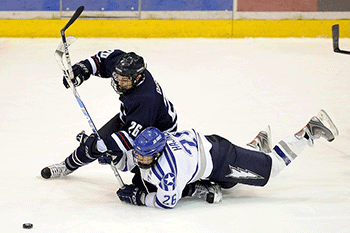Athletes’ head injuries can provoke surprisingly long-lasting harm
Even as symptoms from concussion and other injuries fade, brain impairments may last for years

People tend to view sports where people collide with each other as posing the greatest risk of head injuries. But even in solo sports, such as snowboarding, accidents can lead to serious brain trauma.
familylifestyle/iStockphoto
Elite athletes are some of the strongest people in the world. They train day after day to prepare for national and international competitions. Many hope to stand on the Olympic podium with a gold medal. For every athlete who succeeds, though, many others are derailed by injury. And not all of those injuries will be visible.
And elite athletes are not the only ones at risk. Nearly 1 in every 5 U.S. adolescents, for instance, has sustained a concussion. This is a particularly nasty type of head injury. The statistic comes from a new survey reported September 26 in the journal JAMA. And more than 1 in every 20 teens, its data show, reported having been concussed two or more times.
Affected athletes may not be able to compete again for weeks, months — even years. Indeed, scientists and doctors had long thought that concussed people could safely return to regular activities once their symptoms went away. New data now dispute that.
Stopping concussions before they happen may be the only way to prevent long-term damage to the brain and how it works. That’s the conclusion of the researchers behind these studies. And although anyone can sustain a head injury, athletes in many sports face a special risk. Among those most likely to incur a concussion are those who play football and hockey. Those taking part in the winter Olympic sports of snowboarding, skiing and bobsled also are at risk.
Particularly disturbing, new research shows that even without a concussion, head injuries can lead to long-term damage. They may even lead to a brain disease known as CTE.
‘Working memory’ must work harder
Caitlin Hudac, Dennis Molfese and Cathryn Cortesa are psychologists. For a study on concussions they conducted at the University of Nebraska – Lincoln, the researchers worked with 36 college football players. Seventeen of the players had been diagnosed with at least one concussion. Their head injuries had happened at least three years before the study began. The other 19 players had never been concussed. These players made up what’s known as a control group. (That’s an unaffected group used as a comparison.)

All 36 players completed a test of their brain’s working memory. Part of short-term memory, it’s what allows people to hold something in their minds for brief periods of time. One example would be remembering a phone number long enough to dial it.
The researchers found no difference between the two groups in terms of how fast or accurately they could answer test questions. But they did find differences in how the players’ brains had responded. Scans that mapped their brains’ electrical activity showed that concussed players had to work harder to solve the tasks.
In these tests, the athletes viewed a series of letters as they flashed, one by one, across a computer screen. Players had to indicate whether a particular letter was the same as the one displayed two letters earlier. Hudac’s team recorded how quickly the players responded and how accurate they were.
While the players were taking this memory test, they wore a net on their head. It contained 256 sensors. Each of them recorded electrical activity, focusing on different parts of the brain. This type of recording is called an EEG, short for electroencephalogram (Ee-LEK-troh-en-SEF-uh-lo-gram).
The scientists looked at the EEGs to find 1-second-long peaks in electrical activity. These peaks are known as event-related potentials, or ERPs. They show which specific parts of the brain responded as someone performed a task.
As the brain receives a new piece of information, it begins to process it as a match or mismatch, Hudac explains. “The working-memory system is also activated when attention is dedicated to solving the problem.” Each of those steps shows up as ERPs. They appear on recordings as peaks in positive or negative voltage. One happens when the brain recognizes a new piece of information. It can show up again when the brain figures out if it matches. An ERP may occur a third time, too, as attention is focused on the problem.
The team found that players in the concussion group had longer delays before those tell-tale peaks showed up. And when ERPs did occur, the peaks were bigger than those seen in non-concussed players. This suggests that the brains of concussed athletes use more resources to accomplish the same tasks, Hudac says. Simply put: Their brains must work harder.
What’s more, brain areas key to working memory were less active in concussed players. Instead, their brains as a whole worked to accomplish the memory tasks.
So their brains worked harder — and less efficiently — than in athletes who had never had a concussion. It appears the body tries to make up for concussion damage by spreading out memory-processing tasks over a wider part of the brain, Hudac explains.
Her team presented its findings online October 10 in the International Journal of Psychophysiology.
Second study finds related effects
Similar changes in brain activity emerged in a second study. This one, in Canada, involved boys who played hockey. It searched for acute effects — changes measured within days to a few months after a head injury.
Kathryn Manning is an imaging researcher at Western University in London, Ontario. The athletes that her group studied were all between 11 and 14, when they can start body checking. This is when a player drives himself into another to get the puck away from an opponent. Such hard hits can cause concussions. Manning’s group recruited 17 players who had received concussions and 26 more who had not.
The researchers scanned the brains of concussed players twice. The first time was 24 to 72 hours after a concussion. The second scan was three months later. Boys in the control group were scanned just once. The researchers used an imaging technology known as functional magnetic resonance imaging, or fMRI. It uses a strong magnetic field to show which parts of the brain are communicating with each other.
Within three days of a concussion, communication between different brain regions dropped a bit, Manning’s team found. By three months after the injury, many more brain regions were chatting with each other. However, many were doing this even when they were supposed to be at rest.

The concussed brains appeared to over-compensate, Manning now says. Just as Hudac’s team had found, these injured brains were trying to recover from the long-lasting damage by spreading out their work over a larger area. Manning’s team published these data in the October 25 issue of Neurology.
So how long do these effects last?
The answer, says Molfese who worked on the Nebraska study, may be disturbing to hear. “In my opinion, a concussion is a permanent brain injury.”
To know for certain, scientists will need to follow concussion victims for years. On that, Manning and Hudac agree. Such research will help scientists figure out what types of changes take place. It also will help them determine whether concussions truly cause permanent changes to the brain.
For now, it’s clear that the brain works differently after a concussion, says Hudac. “My hope is that we use this information to improve physical environments and contact sports in order to reduce the number of [concussions].”
What helmets can tell science
Another group of researchers is developing new helmets to better protect athletes’ brains. These scientists are at Virginia Tech in Blacksburg. They have placed motion sensors in the head gear worn by football players. These sensors don’t detect brain activity. Instead, they record how fast and in what direction the head moves. Such data are automatically recorded any time a helmet experiences a force of least 10 g’s. (A measure of acceleration, 1 g-force is equal to the pull of Earth’s gravity at sea level.)
Steven Rowson is a mechanical engineer at Virginia Tech. In a recent study, his team worked with boys who played football. All belonged to one of two teams. Those on one team were 9 to 10 years old. Boys on the other team were two years older. The older boys also were larger, weighing an average of 12.5 kilograms (28 pounds) more than the younger players. That size and weight difference meant that the older players had more force behind their plays.

Each athlete wore one of the special helmets during practice and games. The researchers attended those events to record sensor data and make videos of the gameplay. This let them match head movements with specific events. They focused specifically on events in which a player’s head experienced a force of 40 g’s or greater. Such hits are much more likely to cause concussion, Rowson notes.
The older players experienced more of those high-risk hits. Most occurred during blocking and tackling. Not surprisingly, players who spent more time playing also were at higher risk of sustaining one of these dangerous hits. The researchers presented their findings in the December Journal of Neurosurgery: Pediatrics.
The key to preventing concussions is to change the game’s rules and the way people coach, Rowson now concludes. His research group is at work identifying the situations in which players are most likely to get a concussion.
“If we can do things to prevent those scenarios from happening,” he says, “fewer concussions would [occur].” Getting rid of certain practice drills and reducing contact in practice would help, he says. So would enforcing safety rules. For instance, the National Collegiate Athletic Association issued a rule in 2013 that bans players from targeting and contacting defenseless opponents above the shoulders. Anyone who violates this rule is supposed to be thrown out of a game.
Concussions aren’t the only problem
Lee Goldstein is a neuroscientist — someone who studies the brain and nerves. He works at the Boston University School of Medicine in Massachusetts. There he’s been leading a group that focuses on CTE. That’s short for chronic traumatic encephalopathy (En-SEF-uh-LOP-uh-thee). This disease spreads slowly across the brain, destroying different parts along the way. Behavioral changes and memory problems eventually plague many CTE victims.
In a recent study, Goldstein’s group looked at the brains of both people and mice who suffered brain injuries. Some involved concussions. Others did not. But many individuals who experienced repeated head injuries showed signs of brain damage, even when they had not had a concussion.
Especially worrisome: Some had early stages of CTE.
People with CTE become sullen, angry and aggressive. Some become suicidal. Over time, this disease can lead to learning and memory difficulties — eventually even dementia, Goldstein notes. CTE has been found in professional boxers, football players and hockey players. But his team’s new findings suggest that it can occur in anyone who experiences repeated hits to the head. That’s true even if those injuries never cause symptoms of concussion.
Findings by Goldstein’s group appeared online January 18 in the journal Brain.
“CTE may occur independent of concussion,” Hudac from Nebraska notes. “In fact, many argue that concussion is merely a symptom of head injury more broadly, rather than being a separate disorder.” Regardless of how concussion is classified, however, she notes that people who play contact or extreme sports increase their risk of head trauma. So she cautions that they watch out. Repeated hits to the head can pose serious, long-term risks to any athlete’s brain.







